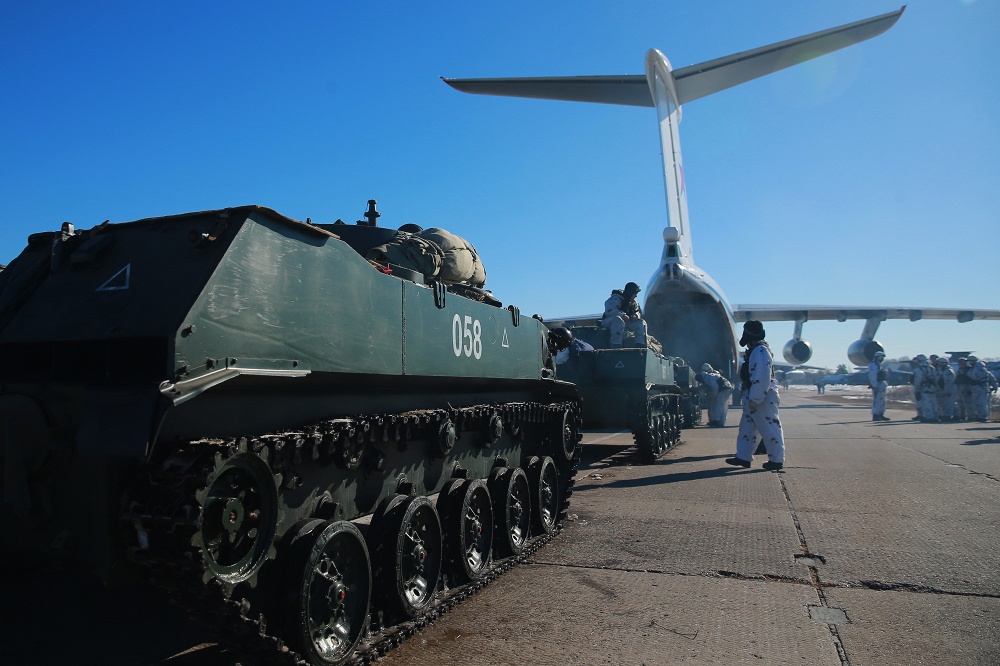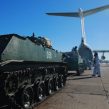
Putin Mobilizes Forces Preparing to Fight With NATO and US
Publication: Eurasia Daily Monitor Volume: 12 Issue: 51
By:

This week (March 16–21), the Russian military began massive, “sudden” military exercises (“vnezapnaya proverka”). The authorities initially announced that the “sudden exercises” are intended to check out the battle readiness of Russia’s Northern Fleet and the possibility of reinforcing it with forces from other military districts. According to the Russian Ministry of Defense, 38,000 soldiers, 3,360 military vehicles, 41 navy ships, 15 submarines and 110 aircraft are involved in the exercise. The mass deployment of air and naval forces in the Barents Sea practices ensuring the safety of Russian nuclear missile–armed submarines, which have to be defended at all costs before they launch their hundreds of nuclear warheads at the United States. The military plans to land marines and paratroopers on the shore of the Kola Peninsula close to the Norwegian border and on the polar archipelagos of Novaya Zemlya and Franz Josef Land.
According to a defense ministry source, the “sudden exercise” was intended to send a message to the North Atlantic Treaty Organization (NATO) that Russia is ready for war and can counter with force the deployment of limited US and other NATO forces to the Baltic, Romania, Poland and Bulgaria. Moscow, apparently, did not give Western nations any prior notification about the exercise (Vedomosti, March 17).
On March 18, the Russian defense minister, Army-General Sergei Shoigu, announced that the “sudden exercises,” though centered on the North Fleet, will in effect cover most of Russia’s national territory, with action in the Baltic region, the Black Sea and Crimea, the Far East, and central Russia. The transport air command, long-range strategic bomber command, strategic rocket forces, and the Airborne troops (VDV) will be involved. Shoigu’s first deputy, the chief of the General Staff, Army-General Valery Gerasimov, is directly in charge of the “sudden exercises,” and a special high-ranking operational staff headed by Gerasimov has been deployed to the Kola Peninsula. According to Shoigu, the “sudden exercises” are more massive in scope than previously announced: 76,000 soldiers, 65 navy ships, 15 submarines and over 200 military aircraft (Mil.ru, March 18).
Marines of the Black Sea Fleet have been mobilized into full battle readiness in Crimea and the North Caucasus’ Taman Peninsula. Russian defense forces in Crimea have been reinforced by ten Tu-22M3 “Backfire” strategic bombers and “a motor-rifle brigade from the Central military district” (Interfax, March 18). Russian forces in the Kaliningrad exclave on the Baltic have been reinforced with jet fighters and bombers from the Russian mainland. A “source in the defense ministry” told Russian state news agencies: “Baltic Fleet landing assault ships are tasked to deliver Iskander ballistic missiles for deployment in Kaliningrad.” During previous military exercises in 2014, Iskander missiles have been temporarily deployed in Kaliningrad, but this was announced after they were reportedly shipped out. The Iskander is capable of delivering a half-ton conventional or a nuclear warhead with high precision at a reported maximum range of 500 kilometers. The Iskanders from the Kaliningrad exclave can hit any target inside Poland, much of the Baltic states, and parts of Germany and the Czech and Slovak republics—all of them being NATO members. The announcement of Iskanders deployed in a forward position aimed at Europe and the deliberate ambiguity about the intention to keep them in Kaliningrad permanently or to withdraw after the end of the “sudden exercises” are intended, according to Russian commentators, as an “information attack” to intimidate Europeans (Regnum, March 17).
This week, Russia is also celebrating with much official pomp the one-year anniversary of the annexation of Crimea. March 18, has been made a regional public holiday in Crimea, and State Duma deputies have proposed to make March 18, a national holiday—The Day of the Unification of Russian Lands. The process of “unification” may not be over and may involve other territories with Russian-speaking populations: parts of Ukraine and the Baltic republics of Estonia, Latvia and Lithuania. According to Duma foreign affairs committee chairman Alexei Pushkov, “In Lithuania, the authorities say they fear Russian aggression and need to hold out three days before NATO reinforcements arrive—that is clearly warmongering” (Rbctv, March 17). In turn, the Lithuanian parliament, this week, rushed through a law to reinstate conscription, which was abolished in 2008. According to the Lithuanian defense ministry, conscription will allow the country to increase the number of soldiers and help form a reserve force (Interfax, March 19).
In a propaganda film aired on prime time by Russia state TV, on March 15, President Vladimir Putin announced that a decision to take over Crimea was taken in the morning of March 23, 2014 (see EDM, March 17). To ensure the Crimea takeover, Russian special forces soldiers, marines and paratroopers were secretly deployed as well as new Bastion batteries with Yahont land-based supersonic anti-ship cruise missiles to fend off the US and NATO navies. According to Putin, the Kremlin was not sure the West would not intervene to prevent the occupation of Crimea and was ready to use nuclear weapons as a measure of last resort: “We were ready for the worst case scenario, but hoped it would not happen.” Putin added: “Our nukes are always ready for action” (Rossiyskaya Gazeta, March 16).
The massive “sudden exercises” of the Russian military this week carry a clear message: Moscow is not ready to stand down and is threatening the use of force, including nuclear weapons. A ceasefire is holding in Ukraine at present, but it is wobbly, and the status quo on the ground does not satisfy Russian long-term aspirations. At a mass state-organized rally to commemorate Crimea’s annexation on March 18, in Moscow close to the Kremlin, Putin declared: “Russians and Ukrainians are one people” (odin narod) (Kremlin.ru, March 18).
In September 2013, the present Ukrainian crisis was still in the making, triggered by Kyiv’s desire to sign an association agreement with the European Union, which Putin utterly opposed. Speaking to reporters in the Kremlin, Putin announced: “No matter what happens, or where Ukraine goes, anyway someday we will be together [as one nation], because we are one people” (Kremlin.ru, September 4, 2013). Putin’s continued assertion of Russians and Ukrainians as “one people” sounds much alike one of the Nazis’ most-repeated political slogans: “Ein Volk, ein Reich, ein Führer”—“One People, One Empire, One Leader.” In pursuit of a dream of the reunification of all the presumed Russian peoples, nuclear blackmail or “brinkmanship” may be used and sudden military exercises will be enacted that are, in essence, direct preparations for possible large-scale war in Europe.




